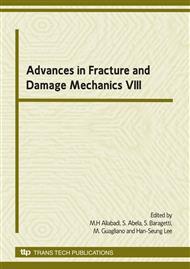p.53
p.57
p.61
p.65
p.69
p.73
p.77
p.81
p.85
Development of Simulations Models under Thermo Mechanical Loading Conditions
Abstract:
Advanced steels are designed and produced to be used in engineering applications in which thermo-mechanical fatigue could be a main factor in causing failure in components operating at elevated temperatures. In this paper thermo-mechanical fatigue properties of these steels are studied under the influence of creep and fatigue damage evolution. Development of different models and simulation techniques are reviewed to predict material behaviour. Numerical simulations are carried out to predict experimental tests on parent material notched bar specimens. Numerical predictions are introduced in advance of experimental test to assess the experimental test procedure. This is usually done to enhance the experimental result integrity and expectations. A local ductile damage development methodology is employed using the kinematic hardening criterion and compared to previously used strain hardening material property. The modelling on notched bar geometries is extended to geometries with cracks in which a local damage criterion will be used to predict virtual crack extension in compact tension specimens.
Info:
Periodical:
Pages:
69-72
Citation:
Online since:
October 2009
Authors:
Price:
Сopyright:
© 2010 Trans Tech Publications Ltd. All Rights Reserved
Share:
Citation:


